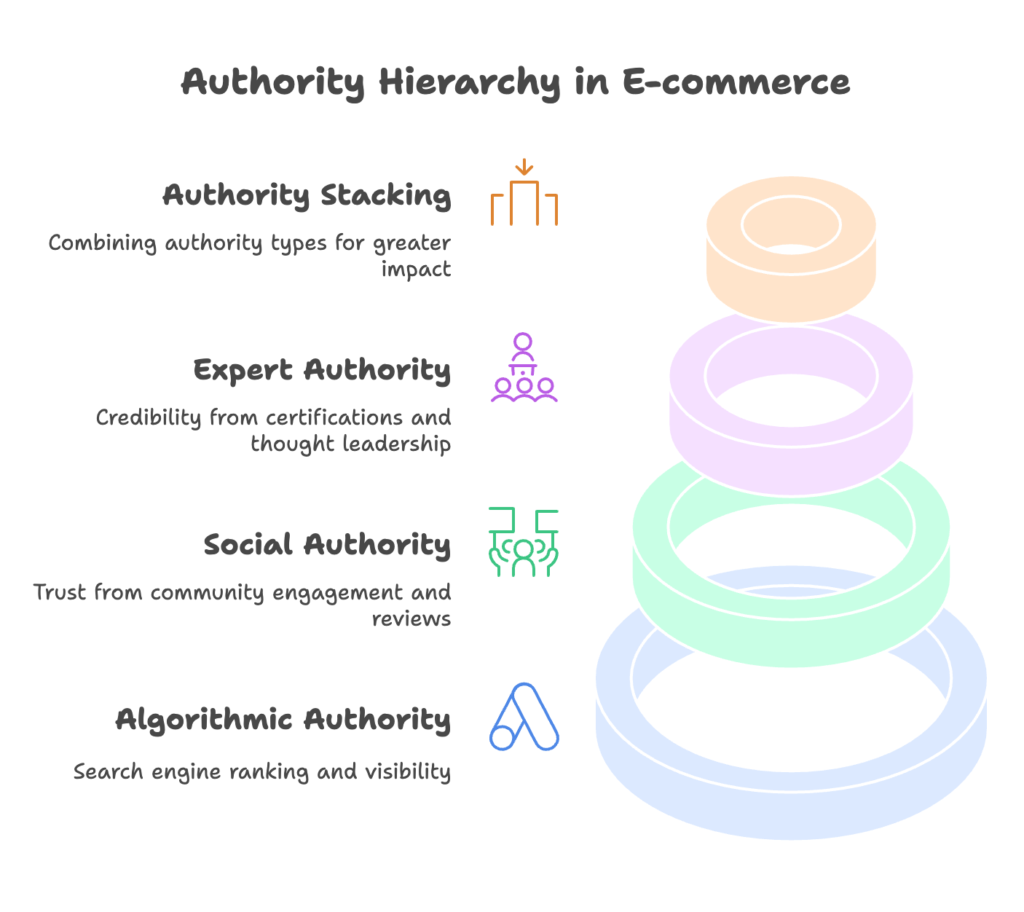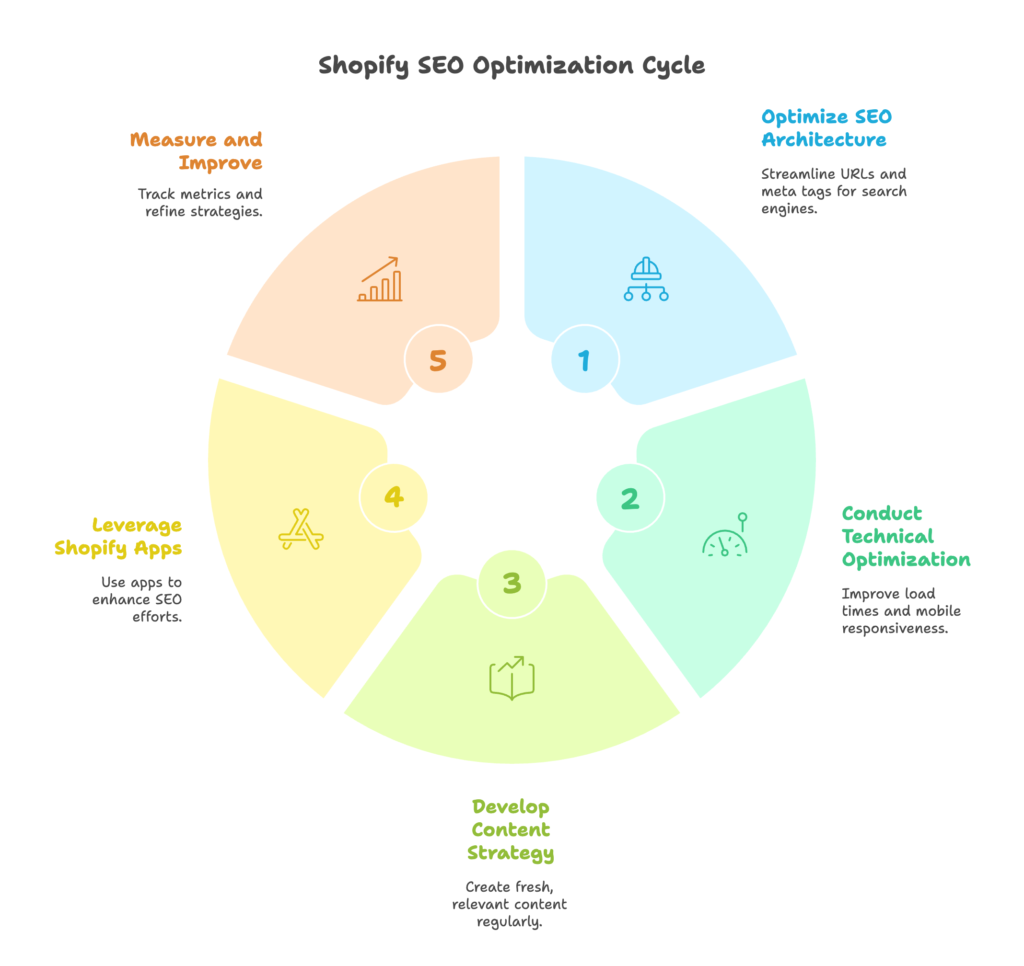Have you ever wondered why some Shopify stores seem to stand out no matter how crowded the market gets? Maybe you’ve asked yourself how they manage to build such trust, visibility, and credibility all at once. If you’re eager to learn their secret, you’re in the right place. By the time you reach the end of this article, you’ll understand how to combine different forms of authority on Shopify to build an online presence people can’t help but notice. Ready to get started? Let’s go!
Understanding Authority in E-commerce
This section explores the concept of authority and why it’s vital for every Shopify store owner. You’ll discover what authority looks like in the digital marketplace, why it matters, and how stacking different types can give you a strong edge. By the end of this section, you’ll see how these ideas lay the groundwork for everything else.

Defining Authority in the Digital Marketplace
Authority, in simple terms, is the power to influence. In the online world, it’s your ability to shape buying decisions, guide opinions, and gain genuine respect from shoppers. For Shopify merchants, this goes beyond just having a nice-looking store. It includes trust, visibility in search results, social proof, and expertise in your niche. When you have authority, you’re not just another store—you become a go-to brand people talk about and recommend.
The Importance of Authority for Shopify Stores
In an ocean of online shops, authority helps you stay afloat. It improves your search engine rankings, makes your brand memorable, and builds lasting relationships with customers. High authority often means repeat buyers, stronger word-of-mouth recommendations, and higher revenue. Shoppers tend to stick with businesses they trust, and authority is a proven way to earn that trust.
Types of Authority Relevant to E-commerce
In e-commerce, authority can come from different places. One form is Algorithmic Authority, which refers to how search engines view and rank your site. Another is Social Authority, which grows from social proof and community engagement. Then there’s Expert Authority, which comes from thought leadership, certifications, and awards. These types can work hand in hand, giving you a holistic advantage in the marketplace.
The Concept of Authority Stacking
Authority stacking is all about combining these different authority types for a bigger overall effect. Instead of focusing on just SEO or just social media, you blend them. For example, you could improve SEO to attract more visitors, then use social proof and expert endorsements to boost conversions. When these forces work together, you create a self-reinforcing cycle of trust and credibility.
You’ve just uncovered the basics of authority in e-commerce. But how does this play out on Shopify, especially from a search engine perspective? Let’s keep moving and see.
Algorithmic Authority on Shopify
Here, we’ll look at how Shopify’s technical setup can help you gain credibility with search engines. We’ll touch on SEO architecture, on-site optimization, content strategy, and specialized apps that give you an extra push. By the end of this section, you’ll be ready to start climbing the rankings.

Understanding Shopify’s SEO Architecture
Shopify has a streamlined structure that search engines understand well. Page URLs, meta tags, and built-in features like sitemap creation simplify the process. When you optimize these elements, search engines can easily crawl your site and rank it higher. Proper use of headings, concise URLs, and well-labeled product categories make your store a friendly place for both visitors and search bots.
Technical Optimization for Algorithmic Authority
Technical optimization lays the groundwork for authority in search engines. That means paying attention to page load times, mobile responsiveness, and proper indexing. Fixing broken links and using SEO-friendly themes also matter a lot. Think of it like tidying up your shop window—when everything’s in place, people (and search engines) are more likely to step in and stay.
Content Strategy for Search Engine Visibility
Fresh, meaningful content is a magnet for search engines. You can add blog posts about your niche, product guides, and helpful FAQs. Search engines notice updates, so posting regularly can boost your rankings. Focus on topics your target audience actually cares about. This wins you both authority and loyalty from readers who see you as a reliable source.
Leveraging Shopify Apps for SEO Enhancement
Shopify’s App Store has many tools designed to sharpen your SEO. Some apps manage meta tags and image alt tags in bulk, while others generate structured data to improve how your listings appear in search results. The right app can save time and help you spot optimization gaps you might have missed manually.
Measuring and Improving Algorithmic Authority
Metrics like domain authority, page rankings, and organic traffic help you see whether your efforts are paying off. You can track these using tools like Google Search Console or specialized apps from the Shopify App Store. If you spot weaknesses—such as pages that barely get traffic—you can refine your approach. It’s a continuous process, but each small improvement adds to your store’s credibility.
We’ve explored how to make search engines your friend. Now let’s see how you can harness the power of online communities and social proof to build another layer of authority.
Social Authority in E-commerce
This section reveals how social signals can transform your Shopify store into a well-known online brand. You’ll find out how to grow a following, gather reviews, collaborate with influencers, and build a sense of community that keeps people coming back. By the end, you’ll have the tools to connect and shine socially.
Building a Strong Brand Presence on Shopify
Brand presence starts with consistent messaging. From your store’s logo to your tone of voice, keep it uniform. That way, people instantly recognize your brand. A distinct brand personality also invites customers to follow you on social media and engage with your content. It’s not just about selling items; it’s about creating a recognizable identity that resonates with your audience.
Leveraging User-Generated Content and Reviews
There’s something powerful about seeing real customers share their experiences. Testimonials, photos, and reviews can build your social authority faster than any self-promotion. Encourage happy buyers to post their thoughts, and highlight these stories on your product pages. This instantly boosts trust because new shoppers see proof of quality and authenticity.
Influencer Partnerships and Collaborations
Teaming up with the right influencers can bring massive attention to your Shopify store. An influencer already has an audience that trusts their recommendations. When they endorse your product or share your store, their audience is more likely to see you as a reliable brand. Just make sure you pick influencers who genuinely connect with your niche.
Social Media Integration with Shopify
Link your store to social platforms like Instagram, Facebook, or TikTok. This makes it easy to showcase products and reach new eyes. Some Shopify themes let you include social feeds right on your homepage, turning your site into a hub for real-time updates. Integrations can also let customers check out directly from social media posts, simplifying the buying process.
Community Building Strategies for Shopify Stores
One of the strongest ways to foster loyalty is through community. Think about creating a forum, a private Facebook group, or a chat community where people can discuss your products or related topics. Host Q&A sessions or exclusive online events. When folks feel part of something bigger, they’re more likely to recommend your brand and come back themselves.
Now you’ve got a handle on social authority. But there’s another layer that adds serious weight: expert status. Let’s look at how you can become a trusted voice in your field.
Expert Authority in Shopify Stores
In this part, you’ll learn how to position yourself as an industry leader. We’ll discuss publishing educational resources, showcasing achievements, and using expert-driven recommendations to reassure shoppers. By the end, you’ll know how to build a solid reputation that keeps people coming to you for answers.
Establishing Thought Leadership in Your Niche
Thought leadership can be as simple as sharing specialized knowledge and advice. Perhaps you’re selling eco-friendly products. You could publish insights on sustainability or share advanced tips on reducing waste. Over time, consistent, high-quality information helps you stand out as a go-to expert in your particular niche.
Creating Educational Content and Resources
Educational materials, like how-to guides or free online workshops, can bring in new customers and keep existing ones engaged. People appreciate stores that do more than just sell—they want genuine support in using products and understanding the industry behind them. Offering clear tutorials or training videos not only helps shoppers but also underscores your expertise.
Showcasing Industry Certifications and Awards
If you’ve received any awards or certifications, don’t be shy about displaying them on your site. Whether it’s an eco-friendly seal, a design award, or a business accreditation, these badges show a higher standard. Visitors who see them may feel more confident in purchasing from your store, knowing you meet recognized benchmarks.
Implementing Expert-Driven Product Recommendations
Expert authority can also be woven into product pages. Provide recommendations from specialists, or highlight how experts in the field use or endorse your products. This strategy can make shoppers feel more certain about their choices, since they’re guided by someone who knows the topic well.
Leveraging Expert Authority in Customer Support
Expertise doesn’t stop at marketing. A responsive, well-trained support team elevates your status and keeps customers loyal. When your support channel offers detailed, helpful answers, it further cements you as a place that truly understands the products it sells. The result? People come to trust and rely on you more.
Expert authority shows you know your stuff. But even the best expertise needs trust signals to confirm credibility. Let’s keep going and see how to build that trust effectively.
Trust Signals and Credibility Markers
This section covers the features that immediately put buyers at ease, from security badges to social proof. You’ll learn how to make your store look and feel trustworthy so that shoppers feel comfortable completing a purchase. After reading this, you’ll know how to present your store as a secure and honest place.
Implementing Security Badges and Compliance Information
Security logos and official compliance notices let people know your store protects their data. Display badges for SSL encryption or payment gateways with a solid track record. Customers appreciate knowing their personal details are safe. They’re more likely to trust you and hit that “Buy” button when they see these markers of security.
Displaying Social Proof and Testimonials
Nothing says “trustworthy” like a lineup of authentic testimonials. You can feature written comments, star ratings, or even pictures of customers with their purchases. The key is authenticity—genuine quotes and names make your store feel transparent and reliable. Shoppers tend to follow the crowd, so positive reviews can influence them to buy.
Transparent Policies and Customer-Centric Approaches
Clear return and shipping policies help customers feel confident about shopping with you. Stating your policies in an easy-to-read format and placing them in visible areas of your site can reduce confusion. A customer-focused approach—like generous return windows—shows you value their peace of mind, encouraging them to trust your brand.
Building Trust Through High-Quality Product Imagery and Descriptions
Blurred or generic product photos can make a store seem unprofessional. High-resolution images from multiple angles, along with detailed but plain-language descriptions, reassure shoppers they know exactly what they’re buying. This extra care tells people you’re committed to honesty and thoroughness, which naturally boosts trust.
Leveraging Trust-Building Shopify Apps
Some Shopify apps are designed to strengthen shopper confidence. They might add live chat functionality, social proof pop-ups, or easy-to-use return systems. Find apps that fit your brand’s needs and use them to enhance the overall buying experience. It’s an efficient way to offer the reassurance modern shoppers expect.
Now that you know how to inspire trust, it’s time to look at how a smooth user experience can further elevate your store’s authority. Let’s keep the momentum going.
Authority Through User Experience
In this segment, we’ll talk about creating a user-friendly shop that appeals to the senses and logic of your visitors. You’ll see how design, speed, and personalization can amplify your store’s credibility. By the time you finish, you’ll have a strong handle on making your store a joy to use.
Designing for Cognitive Ease and Intuitive Navigation
Cognitive ease is a fancy way of saying, “Make things simple for people.” Keep your layout uncluttered, group related products together, and use clear calls to action. When visitors can navigate easily, they’re more likely to stay, explore, and eventually buy. This sense of ease often translates to higher perceived authority.
Optimizing Site Speed and Performance
Online shoppers lose patience if pages take too long to load. A speedy site not only pleases people but also impresses search engines. Compress images, use responsive themes, and limit heavy scripts. A fast-loading store keeps potential buyers engaged and signals that you pay attention to the details.
Creating a Seamless Mobile Shopping Experience
Many shoppers do everything on their phones, from browsing to buying. Your Shopify store should adapt fluidly to mobile screens. Make sure images resize properly, text is easy to read, and buttons are large enough to tap. This smooth mobile experience can mean the difference between a bounce and a sale.
Personalizing the Customer Journey
Personalization can turn casual shoppers into loyal fans. Recommend products based on browsing history or offer targeted discounts that resonate with individual users. When people feel they’re getting a custom experience, they trust your brand more. This added layer of attention can make your store unforgettable.
Implementing Accessibility Features for Inclusive Authority
Accessibility features—like image alt text, keyboard navigation, and proper contrast—welcome everyone. This shows you care about all users, reinforcing a strong and ethical reputation. It’s also good for SEO, as search engines reward sites that meet accessibility standards. Everybody wins when your store is inclusive.
You’ve just discovered how a well-crafted user experience boosts authority. Next, let’s explore how content can further solidify your reputation and make your store the go-to resource in your field.
Content Authority Strategies
In this part, you’ll learn why content is such a powerful way to demonstrate expertise. We’ll go over blog posts, videos, podcasts, and even interactive tools. Once you finish reading, you’ll have plenty of ideas for turning your knowledge into engaging material that keeps people coming back.
Developing a Complete Content Marketing Plan
A solid content plan goes beyond random blog updates. It involves setting goals, choosing your channels (like your Shopify blog, YouTube, or a newsletter), and planning a calendar of topics. This organized approach makes sure your content is relevant, timely, and aligned with your store’s overall brand identity.
Creating Authority-Building Blog Content
Blogging offers a chance to share tips, insights, and news that resonate with your shoppers. Write about challenges your audience faces, offer solutions, and include examples from real customers if possible. This creates a sense that you understand your shoppers and can guide them, thereby increasing your authority.
Leveraging Video Content for Product Demonstrations and Education
Not everyone wants to read a long article. Some prefer to watch short videos showing how to use a product or explaining a key concept. By uploading these videos to your Shopify store or a platform like YouTube, you reach a wider audience. It’s also an opportunity to show your face, tone, and personality, which boosts trust.
Podcast Integration for Niche Authority
Podcasts let you connect with people on the go. You can talk about industry trends, interview specialists, or share success stories from your customers. It’s another medium for spreading your expertise in an engaging way. Plus, podcasts can be embedded on your Shopify site, helping visitors learn as they browse.
Interactive Content and Tools to Showcase Expertise
Interactive quizzes, calculators, or checklists can make your store feel informative and lively. For example, a skincare shop might offer a quick quiz that suggests the perfect product routine. These tools both help shoppers and display your knowledge, enhancing your credibility on the spot.
With content in your arsenal, you’re nearly unstoppable. Now, let’s see how to round out your store with technical tweaks that give you even more credibility in the eyes of both people and search engines.
Technical Authority Implementation
Here, we’ll dig into some of the more specialized actions you can take on Shopify to boost authority. We’ll talk URL structure, structured data, third-party tools, and performance tweaks. By the end, you’ll see how these behind-the-scenes elements elevate your store’s standing.
Optimizing Shopify’s URL Structure for Authority
A clean URL makes it easier for search engines and users to understand your pages. Short URLs that include primary keywords work best. For instance, yourstore.com/products/summer-hat is more straightforward than yourstore.com/collections/sale/item12345. This small detail can lead to better search rankings and user trust.
Implementing Structured Data for Enhanced SERP Presence
Structured data gives search engines extra information about your pages. By adding it, your store might appear with extra elements in search results, like star ratings or images. This not only draws attention but also boosts credibility. Shopify apps or manual coding can be used to implement structured data.
Leveraging APIs for Advanced Functionality
APIs allow you to link services and share data seamlessly. You might connect your Shopify store with a mailing list service to automate email campaigns or integrate your CRM for real-time inventory and order tracking. These advanced features make shopping smoother for customers, which reflects well on your store’s professionalism.
Integrating Third-Party Tools for Enhanced Authority
Sometimes, specialized tools can handle tasks better than built-in Shopify features. You might add a reviews platform that verifies customer feedback or an analytics tool with more in-depth insights. Each integration has the potential to strengthen your authority by making your store more robust and user-friendly.
Performance Optimization Techniques for Shopify Stores
Performance goes hand in hand with trust. Caching, image optimization, and removing unused apps can keep your store lightning-fast. The faster the site, the better the user experience and the more likely visitors are to trust your brand. Speed also positively influences SEO, making it a win-win.
With your technical foundation set, it’s time to see how everything ties together in measurable ways. Let’s look at how to track and understand your progress.
Measuring and Analyzing Authority Impact
This section shows you how to gauge the results of your authority-building efforts. From metrics to A/B tests, you’ll learn how to analyze what’s working and what’s not. By the time you’re done reading, you’ll have a clear idea of how to fine-tune your approach.
Key Performance Indicators for Authority Measurement
Authority can be measured in both qualitative and quantitative ways. On the numbers side, look at things like your domain rating, organic traffic, and social shares. Qualitatively, monitor user engagement and repeat business. These metrics paint a realistic picture of how your authority is evolving over time.
Tools for Tracking Authority Metrics on Shopify
Google Analytics, Google Search Console, and specialized Shopify apps can help you collect data. You can see where traffic is coming from, which products get the most views, and how users interact with your site. Regularly reviewing these statistics allows you to adjust your strategies and catch problems early.
A/B Testing Authority-Building Elements
Want to know if adding a security badge increases conversions? Test it. A/B testing means presenting two versions of a page to see which one performs better. Try different headlines, images, or trust badges. Over time, these tweaks can significantly improve your store’s perceived authority.
Long-Term Authority Tracking and Trend Analysis
Authority is not a “set it and forget it” game. Consistently monitor your data over weeks, months, and even years. Look for patterns—like seasonal dips or product categories that always perform better. This long-term focus helps you adapt and maintain momentum.
ROI Calculation for Authority Stacking Investments
If you’ve put money into SEO, influencer marketing, or specialized apps, you want to see returns. By comparing revenue increases and brand awareness metrics to what you’ve spent, you can figure out whether your authority-stacking efforts are profitable. If something’s not paying off, you can pivot before it drains resources.
You’re now equipped to measure your authority. Lastly, let’s see how to keep this momentum going so that your store remains influential well into the future.
Future-Proofing Authority on Shopify
In this final section, we’ll look at how to stay relevant in a changing market. You’ll discover emerging trends, how to handle shifting consumer expectations, and how to do all this in an honest, sustainable way. By the end, you’ll have a roadmap for keeping your authority strong, no matter what happens next.
Emerging Technologies and Their Impact on E-commerce Authority
Technologies like AI-driven shopping assistants or augmented reality try-ons can shape how people shop. Staying informed about these tools gives you a head start. Adopting new tech ahead of competitors can position you as a leader in innovation, boosting your store’s authority in fresh ways.
Adapting to Changing Consumer Trust Signals
What worked last year may not work forever. Shoppers’ expectations change, and new trust signals emerge. Keeping a watchful eye on customer feedback and watching your competitors can help you respond quickly. When you adapt at the right time, you stay relevant and continue to be viewed as reliable.
Preparing for New Shopify Features and Integrations
Shopify regularly releases updates and new tools. Stay updated through Shopify’s announcements and online communities. Early adoption of these features can enhance both your user experience and your store’s credibility. Plus, it keeps your store modern and well-equipped to handle shifting trends.
Sustainable Authority-Building Practices
Long-lasting authority takes time and honesty. Instead of using quick tricks, invest in quality content, honest communication, and genuine relationship-building. When customers see you consistently delivering on promises, they stay loyal, and your authority grows naturally.
Ethical Considerations in Authority Stacking
As your influence grows, it’s wise to remain ethical. This means avoiding fake reviews or shady SEO practices. Shoppers are quick to spot insincerity. Real authority relies on authentic actions that benefit your audience. That’s how you’ll stand the test of time.
Now you have the knowledge to build a robust, long-lasting presence. Let’s wrap up with the references and then share a quick reminder on how you can boost your sales even more.
References
- Shopify. (2024). How to Build an Ecommerce Tech Stack in 2025. https://www.shopify.com/enterprise/blog/ecommerce-tech-stack
- Webstacks. (2024). 8 Trust Signals You Must Have on Your Website. https://www.webstacks.com/blog/trust-signals
- LitExtension. (2024). 40+ Successful Shopify Store Examples to Inspire You. https://litextension.com/blog/shopify-store-examples/
- Digital Commerce. (2024). Rank Higher, Sell Smarter with Shopify SEO services. https://digitalcommerce.com/services/shopify-seo/
- BetterUp. (2025). How Using Different Types of Authority Affects Leadership. https://www.betterup.com/blog/types-of-authority
- Ron Sela. (n.d.). Authority Marketing: Establish Yourself as an Industry Leader. https://www.ronsela.com/authority-marketing/
Ready to boost your Shopify store’s sales with optimized discount codes? Growth Suite is a Shopify app that helps you do just that. Install it with a single click and watch your revenue grow!




